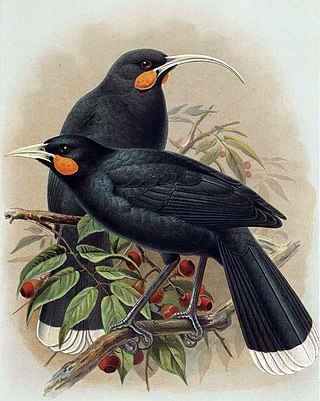
The huia is an extinct species of New Zealand wattlebird, endemic to the North Island of New Zealand. The last confirmed sighting of a huia was in 1907, although there was another credible sighting in 1924.
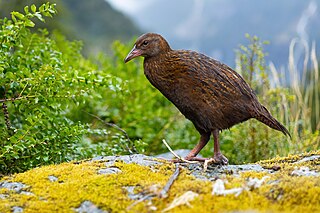
The weka, also known as the Māori hen or woodhen is a flightless bird species of the rail family. It is endemic to New Zealand. It is the only extant member of the genus Gallirallus. Four subspecies are recognized but only two (northern/southern) are supported by genetic evidence.
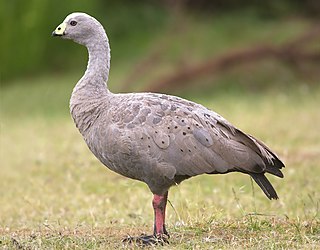
The Cape Barren goose, sometimes also known as the pig goose, is a species of goose endemic to southern Australia. It is a distinctive large, grey bird that is mostly terrestrial and is not closely related to other extant members of the subfamily Anserinae.

The bushwren, also known as the mātuhituhi in the Māori language, was a very small and almost flightless bird that was endemic to New Zealand. It had three subspecies on each of the major islands of New Zealand, the North Island, South Island, and Stewart Island / Rakiura and nearby smaller islands. The species disappeared gradually after the introduction of invasive mammalian predators, last being seen on the North Island in 1955 and the South Island in 1968. Attempts were made to save the remaining population on small islands off Stewart Island, but they ultimately failed with the death of the last remaining known birds in 1972.

The New Zealand bellbird, also known by its Māori names korimako, makomako, and kōmako, is a passerine bird endemic to New Zealand. It has greenish colouration and is the only living member of the genus Anthornis. The bellbird forms a significant component of the famed New Zealand dawn chorus of bird song that was much noted by early European settlers. The explorer Captain Cook wrote of its song "it seemed to be like small bells most exquisitely tuned". The species is common across much of New Zealand and its offshore islands as well as the Auckland Islands.

The South Island piopio also known as the New Zealand thrush, was a passerine bird of the family Oriolidae.
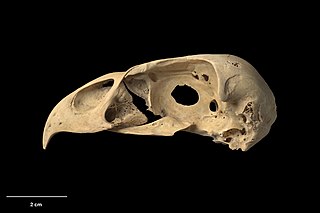
Eyles's harrier is an extinct bird of prey that was endemic to New Zealand.
The Tasman starling was described in 1836 by John Gould as a species which occurred on both Norfolk Island and Lord Howe Island. In 1928 Australian ornithologist Gregory Mathews recognized that the plumage of the race from Lord Howe Island was much browner and more greyish than the plumage of the Norfolk Island race and split the species into two forms, the Norfolk starling, and the Lord Howe starling. Both subspecies are now extinct, thus so the species.
Insulanoplectron is a genus of cave wētā in the family Rhaphidophoridae, with just one species: the Snares Island Wētā. Insulanoplectron spinosum is endemic to the subantartic Snares Island of New Zealand, where it is considered to be naturally uncommon. Wētā are nocturnal crickets found all around the world. During the day on the Snares, wētā can be found hiding in seabird burrows.
The Synthetonychiidae are a small family of harvestman with a handful of species in a single genus. They are endemic to New Zealand.

Steatoda capensis is a spider originating from South Africa. Its common names include the black cobweb spider, brown house spider, cupboard spider and due to its similarities to the katipō spider it is commonly known as the false katipō in New Zealand. Common throughout Southern Africa, it has been introduced into other countries and is now present in Australia and throughout New Zealand. It is a small spider, usually an all-over shiny black. It may have a small bright red, orange, or yellow patch near the tip of the abdomen along with a crescent shaped band near the front of the abdomen.

Pisinna rekohuana is a species of marine gastropod mollusc in the family Anabathridae. First described by Badwn Powell in 1933 as Estea rekohuana, it is endemic to the waters of New Zealand. There are two subspecies of the gastropod: Pisinna rekohuana rekohuana, primarily found in the south and Pisinna rekohuana lactorubra, primarily found on the north-east coast of the North Island.

Algidia chiltoni oconnori is a subspecies in the genus Algidia in the harvestman family Triaenonychidae. It is found the lower North Island of New Zealand. Only male specimens are known, leading Ray Forster to speculate that it could be a second male form of Algidia chiltoni chiltoni even though male dimorphism is unknown in Algidia.
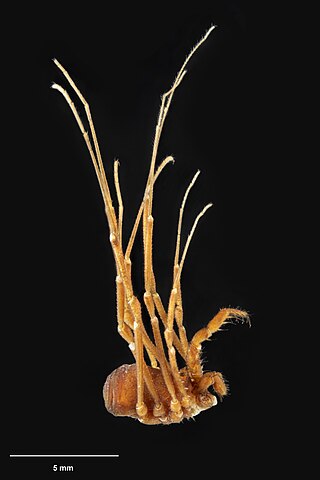
Prasmiola unica is the only member of the genus Prasmiola in the harvestman family Triaenonychidae. It is found near Wellington, New Zealand, and is known from a single specimen. The New Zealand Threat Classification System status for this species is 'nationally critical'.

Algidia is a genus in the harvestman family Triaenonychidae. It is endemic to New Zealand and currently includes 7 species and several subspecies.
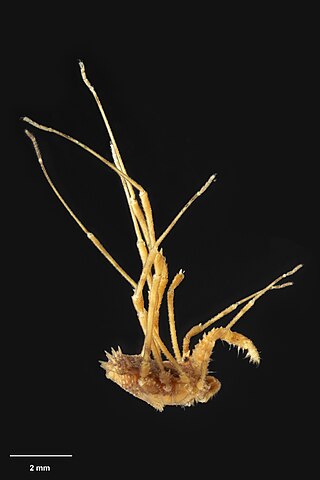
Algidia chiltoni longispinosa is a subspecies in the genus Algidia in the harvestman family Triaenonychidae. It is found in the Horowhenua district and Wairarapa region in the lower North Island of New Zealand. Ray Forster placed it as a subspecies of Algiidia chiltoni.

Algidia chiltoni is species in the genus Algidia in the harvestman family Triaenonychidae. Endemic to New Zealand, the species is found in most of the North Island as far north as Auckland and in the north-western part of the South Island. Carl Fredrich Roewer described this species in 1931 after realising the females in the type material of Algidia cuspidata Hogg, 1923 were a separate species. Ray Forster revised the genus Algidia in 1954, redescribing Algidia chiltoni and describing two new subspecies.
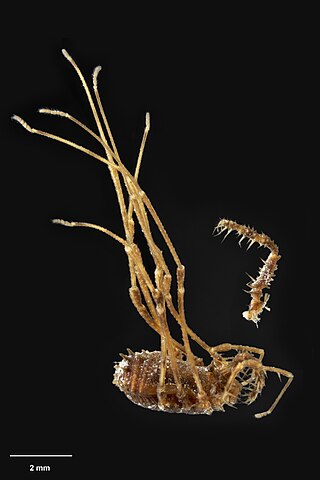
Algidia homerica is a species in the genus Algidia in the harvestman family Triaenonychidae. It was collected at Homer in the Fiordland region of New Zealand. Only a single female specimen is known.
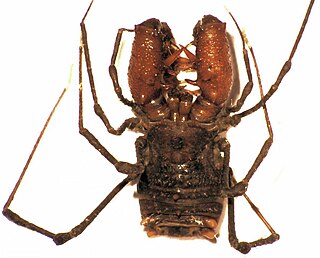
Sorensenellinae is a subfamily of harvestmen in the family Triaenonychidae created by Ray Forster. It includes genera from New Zealand and South Africa, but later phylogenetic studies do not support the inclusion of the South African taxa. Egg guarding is reported in both New Zealand genera and appears to be an example of paternal care.

Sorensenella is a genus in the harvestman subfamily Sorensenellinae in the family Triaenonychidae. It is endemic to New Zealand and currently includes three species and several subspecies. Members of this genus have large pedipalps armed with strong spines. The pedipalps are larger in males.

















